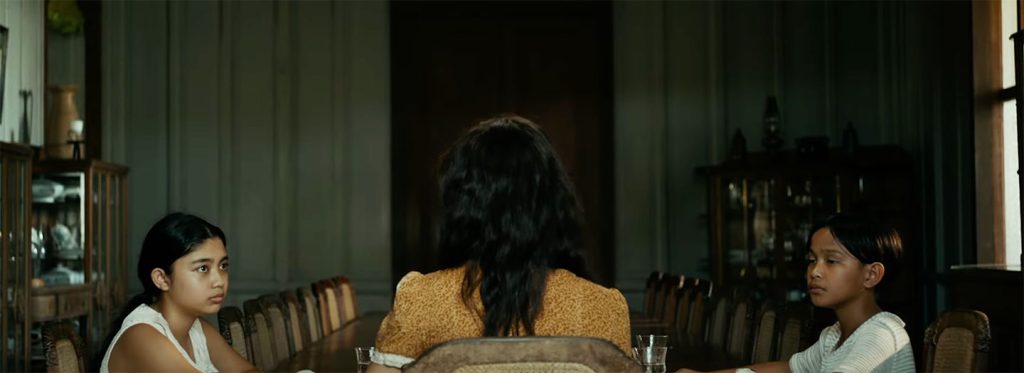MANILA, PHILIPPINES — In My Mother’s Skin, an Amazon Original horror film by Cebuano writer-director Kenneth Dagatan, opens on a promising note for fans of the genre: a man engages in a brutal act of cannibalism, bathed in blue moonlight, as the ominous din of cicadas fills the air. It’s a gloriously visceral sight; it’s probably also the scariest thing in the movie’s mostly dreary 97-minute runtime.
The film premiered at Sundance earlier this year, having the distinction of being the only non-English entry in the festival’s “Midnight” section, which saw the premieres of modern genre favorites like Hereditary, It Follows, and the deranged, delicious FRESH. For the most part, it’s easy to see why Kenneth’s story earned its spot among such distinguished company—In My Mother’s Skin’s shots are beautifully framed, while the film itself opens a window to a fascinating world not often explored in cinema.
In My Mother’s Skin takes place during World War II, with the Philippines firmly under the heel of Japanese occupation. Tala (Felicity Kyle Napuli) is stranded along with her mother, Ligaya (Beauty Gonzalez), and her brother, Bayani (James Mavie Estrella), in their rural mansion. Her father, Aldo (Arnold Reyes), has gone to seek help from American forces, leaving the family to fend for themselves amidst dwindling food supplies and Ligaya’s worsening health.
Further complicating matters is defector Antonio (Ronnie Lazaro), who has been intimidating the family under suspicions that Aldo had stolen Japanese gold and is hiding it somewhere in the house. Antonio is secretly colluding on the matter with Amor (Angeli Bayani), the household helper, whose husband is being held prisoner by the Japanese.
As things grow increasingly desperate, Tala takes it upon herself to find help. She and her brother venture into the forest, getting separated when disembodied voices lead them towards separate paths. While Bayani stumbles upon a nightmarish sight, Tala discovers an abandoned forest shrine. It is here that she meets the film’s duplicitious antagonist, the diwata (Jasmine Curtis-Smith), who later offers her a cure for her mother’s ailment in the form of a cicada.
The diwata warns her, however, that though the cicada may restore her mother’s health, it could also enter her body. Tala decides that her mother’s health is worth the risk and accepts the help.
The cicada does cure Ligaya’s ailment, but it also transforms her into something frighteningly beyond human, putting Tala and her brother in even greater danger than before.

The story alone gives In My Mother’s Skin the potential to be a dark fairy tale in the same vein as Pan’s Labyrinth (which was no doubt a significant inspiration), but there are odd choices smattered about the film that hinder it from truly excelling in any single aspect. Characters are well-performed, but written rather flatly. Tala, for instance, is played convincingly by Felicity as a terrified adolescent at the end of her rope, but the script gives her little depth once the main plot sets in. Sing Wu’s score creates a wonderfully broody atmosphere throughout the film, but fails to punctuate emotions when scenes call for it.
Of particular note in this regard is the film’s visual language; the direction, cinematography, and editing all combine to give the impression of a horror film afraid of being scary. Scenes of true terror often play out offscreen or are cut away from too quickly. Scares in the dark are easily missed simply because the lack of contrast renders key details invisible, at least on this reviewer’s TV. The puzzling choice to show a child being shot (trigger warning for those concerned), but not the antagonist being ripped to shreds pulls into question what the decision-making process in the cutting room was like.
There is also a distinct lack of tension permeating throughout the film, which is a cardinal sin for the style of horror In My Mother’s Skin is attempting. Tala is too often made to slowly walk about the house and discover something frightening, but the lack of direct scares resulting from those filmmaking choices detailed above means that there are no real stakes creating the necessary tension. If viewers aren’t made to see the violence her monstrous mother wreaks, why should they be afraid for Tala? Horror films that rely this heavily on mood need to justify it by establishing the very real danger their protagonists are in.

Perhaps the most difficult part of In My Mother’s Skin to swallow, however, lies in the execution of its central theme: to be wary of the choices we make. The plot is driven entirely by the bargains Tala makes with the diwata, which rings true with folklore. At the same time, however, Tala is never fully informed about the consequences of her choices before she makes them, rendering the film’s thesis into a bout of victim-blaming. Tala was only told that the cicada may enter her mother, not that it would turn her into a flesh-eating creature; would she have made the same choice had she been told that?
But the diwata hoists all responsibility over Ligaya’s ordeal onto Tala simply for having made her choice, and even gaslights her into thinking she made the right call. While it’s possible that Kenneth intended this interplay between victimhood and victim-blaming to be a part of the film’s message, its delivery within a package that offers little in terms of truly engaging viewers will more often than not leave that message muddied by boredom.
Which is a shame, really, because In My Mother’s Skin had the potential to open up deeper discussions on the matter of choice. There are, for instance, parallels that can be drawn between Tala’s desperation-driven choices and real-world elections; voters in dire straits might opt for riskier candidates, as Tala did with the cicada. The diwata badgering Tala about her mother’s condition being solely her choice mirrors the “ginusto mo ‘yan” (“you wanted this”) rhetoric often seen in political rants on Philippine social media.
However, with Tala being largely passive in terms of the resolution—in fact, the resolution itself was essentially inaction—the film intentionally or otherwise recommends passivity in its real-world parallels as well. The film’s protagonist doesn’t hold the diwata to account beyond telling her she lies, nor does she actively pursue a better choice outside of what the diwata offers. Tala simply leaves it all behind, walking into a dark, lonely night filled with the sounds of war. There is no absolution for making her choices under duress; they remain her responsibility alone, and therefore her consequences to live with.
In My Mother’s Skin offers a lot of potential, but rarely lives up to it. For those simply looking for more Filipino stories, it may yet prove enjoyable; there’s just enough polish to make it a serviceable watch. But for audiences looking for something deeper in their horror films, or at the very least something genuinely scary, there are better choices this Halloween season.
In My Mother’s Skin is currently streaming on Amazon Prime.








